As a seasoned bass maestro, I’ve spent years laying down those funky beats that get the whole room grooving.
From my early days of learning to play to rocking out on stage with renowned bands, I’ve seen it all when it comes to the magical world of the bass guitar.
Get ready to embark on a journey through the captivating realm of the electric bass guitar, the parts of the Bass Guitar, and how they play a crucial role in creating that punchy, smooth sound that keeps the rhythm alive.
Think of it as assembling a rockstar team, and you’re the mastermind behind the music! From the headstock to the bridge, we’ll uncover the secrets that give the bass guitar its soulful voice. It’s not rocket science; it’s way cooler, and you’re just a few funky-facts away from becoming a bass aficionado.
So, join me as we unravel the details together and explore the heartbeat of the bass universe. Let’s hit that bassline and see where the rhythm takes us!
Headstock Components
Your bass guitar’s headstock is a hub of critical hardware, playing an essential role in maintaining string tension and tuning.
It consists of precision parts, ensuring your instrument stays in tune and is ready to rock at a moment’s notice.
Tuning Pegs
At the edge of the headstock, you’ll find the tuning pegs, also known as tuning keys or tuning machines.
They’re your go-to buddies when your bass sounds out of whack. Twist them, and you tighten or loosen the strings, making your bass sound pitch-perfect. Each string winds around an individual post, allowing precise tuning adjustments.
- Function: Adjustment of string tension and pitch
- Location: Edge of the headstock
- Movement: Twist to increase or decrease tension

Nut
Just below the headstock, sitting at the junction where the neck meets the headstock, lies the nut.
It’s like a checkpoint for strings, keeping them properly spaced and maintaining the right height above the fretboard.
This little piece, typically made of bone, plastic, or even metal, has grooves that guide each string to its own tuning post.
- Materials: Bone, plastic, or metal
- Purpose: Maintain string spacing and height

String Tree
Sometimes, your bass strings need a little extra help to stay snug against the nut. That’s where the string tree, also known as a string retainer, steps in.
This small yet mighty component holds down the strings to ensure they pass over the nut at an optimal angle.
It’s all about keeping unwanted buzz and vibration out of your epic bass lines.
- Role: Maintain optimal string angle and tension over the nut
- Benefit: Minimizes unwanted buzz and vibration

Neck and Fingerboard
Dive right into the heart of your bass guitar with the neck and fingerboard—a playground where melody and rhythm meet.
Your fingers will dance across the fretboard while the neck confidently supports each note’s reverberation.
Fretboard
Imagine the fretboard as the stage where your fingers perform.
Crafted from woods like maple or rosewood, it harbors a specific radius and thickness that influence the action or the height of the strings above the frets.
The radius affects how flat or curved the playing surface is—an essential factor for your playing comfort.
Play it just right, and your bass will respond with precise vibrations that sing through each octave.

Frets
Frets are the metal strips that divide the fretboard, laying out the roadmap to pitch perfection.
These raised markers define where you place your fingers to churn out the desired notes.
In fretless basses, where fretlines are absent, you rely solely on your ears and muscle memory to find the sweet spots for intonation.
On-standard models, frets facilitate accuracy, keeping your grooves clean and your pitches on point.

Truss Rod
Tucked inside the neck, the truss rod is your unsung hero. It’s an adjustable metal rod found underneath a small plastic cover called the truss rod cover, which manages the neck’s curvature.
Ever feel that your strings are too high or too low? That’s the action calling your attention.
With the right tweak of the truss rod, you’ll balance the tension and maintain an ideal action to play bass guitar comfortably.
In short, it keeps your bass neck straight, making sure every note frets with ease and confidence.

Body and Bridge
Dive into the heart of your bass guitar—the body and bridge section is where much of the magic happens. From the resonance of the body to the anchor point of the strings, each component plays a pivotal role.
Pickups
Your bass guitar’s pickups are the primary translators of string vibrations into electrical signals. They’re typically positioned on the body section beneath the strings.
Think of them as the microphone for your bass: they capture the sound and let your amp project it.
Depending on the model, you might find them encased in a pickguard or scratchplate to protect the body’s finish from picks and fingers.
The two most prevalent designs are split coil and single coil pickups, with the Fender Jazz bass guitar featuring two single coil pickups.
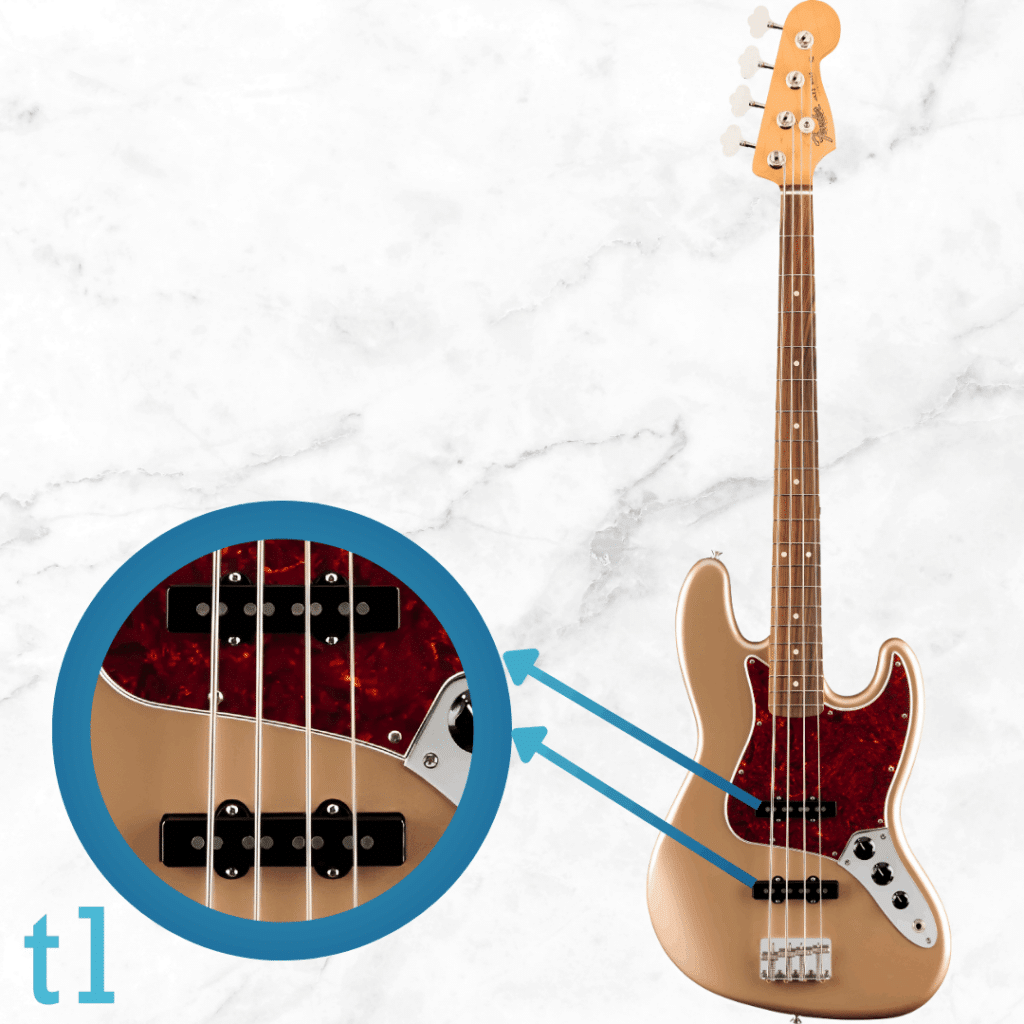
Meanwhile, the split coil pickup, commonly found on Fender Precision basses, consists of two single coil pickups split apart, each covering two bass strings.
Bridge
The bridge forms the foundation where the strings meet the body at the lower end.
Here lies the saddle, which supports the strings and can sometimes be adjusted for height and intonation.
A solid-body bass guitar will exhibit different tonal qualities depending on the bridge’s material, typically made of metal and the way it’s engineered to transfer string vibrations to the body.
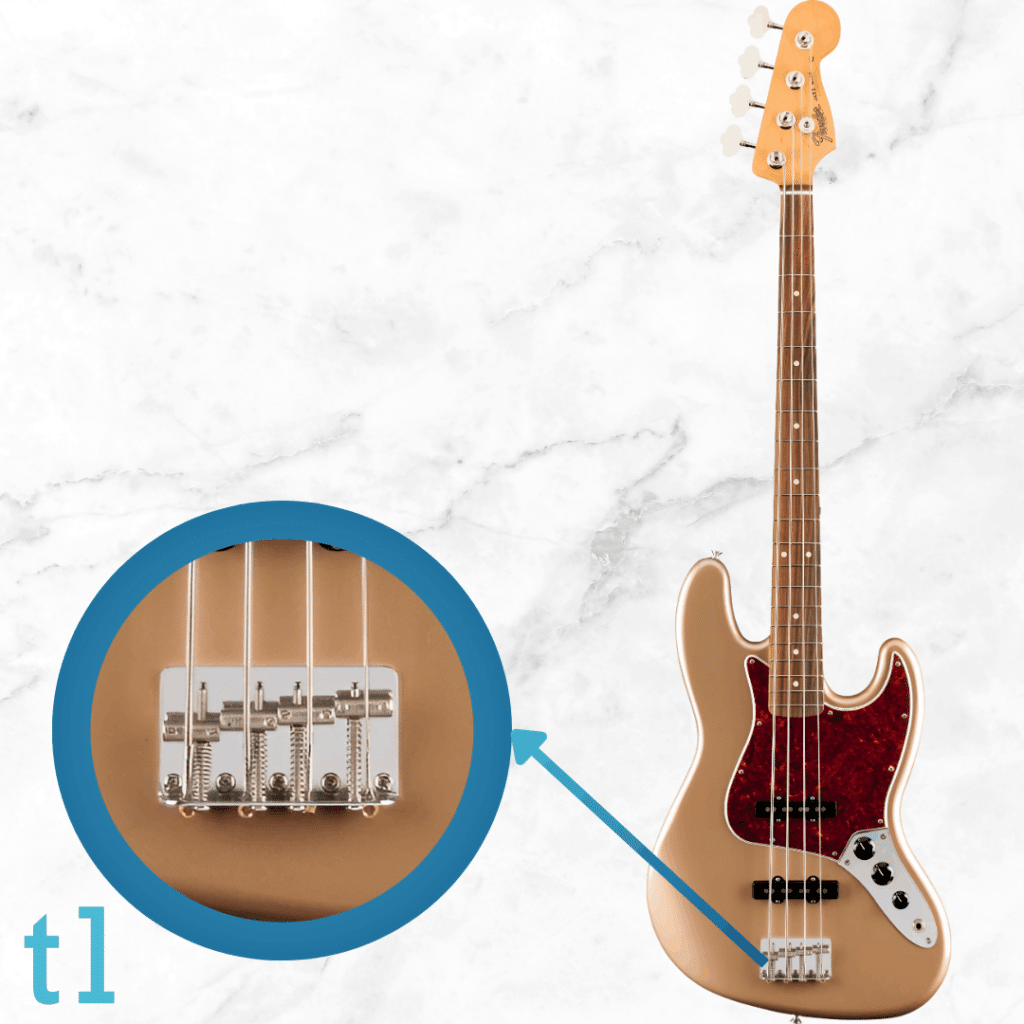
Strap Buttons
Notice the small, unassuming strap buttons? These can be found on the upper and lower bouts of the bass body, providing a secure place to attach your strap.
Without them, you’d have a hard time keeping the bass in position while you play.
Whether they’re called strap buttons or strap pegs, they ensure that your beloved instrument stays safely strapped to you so you can move and groove without care!

Electronics and Hardware
When you’re getting to grips with your bass guitar, the electronics and hardware are your silent powerhouse, a treasure trove of tone-shaping tools at your fingertips.
Let’s open that treasure chest and see what makes your bass buzz.
Control Knobs
Your bass’s control knobs are like a personal sound studio—twist and turn to shape your soundscapes.
Typically, you’ll find a volume knob to control the overall output and a tone knob to adjust the brightness or warmth of your sound.
These knobs let you tweak the precision and tension in your notes, allowing for a tailored playing experience.
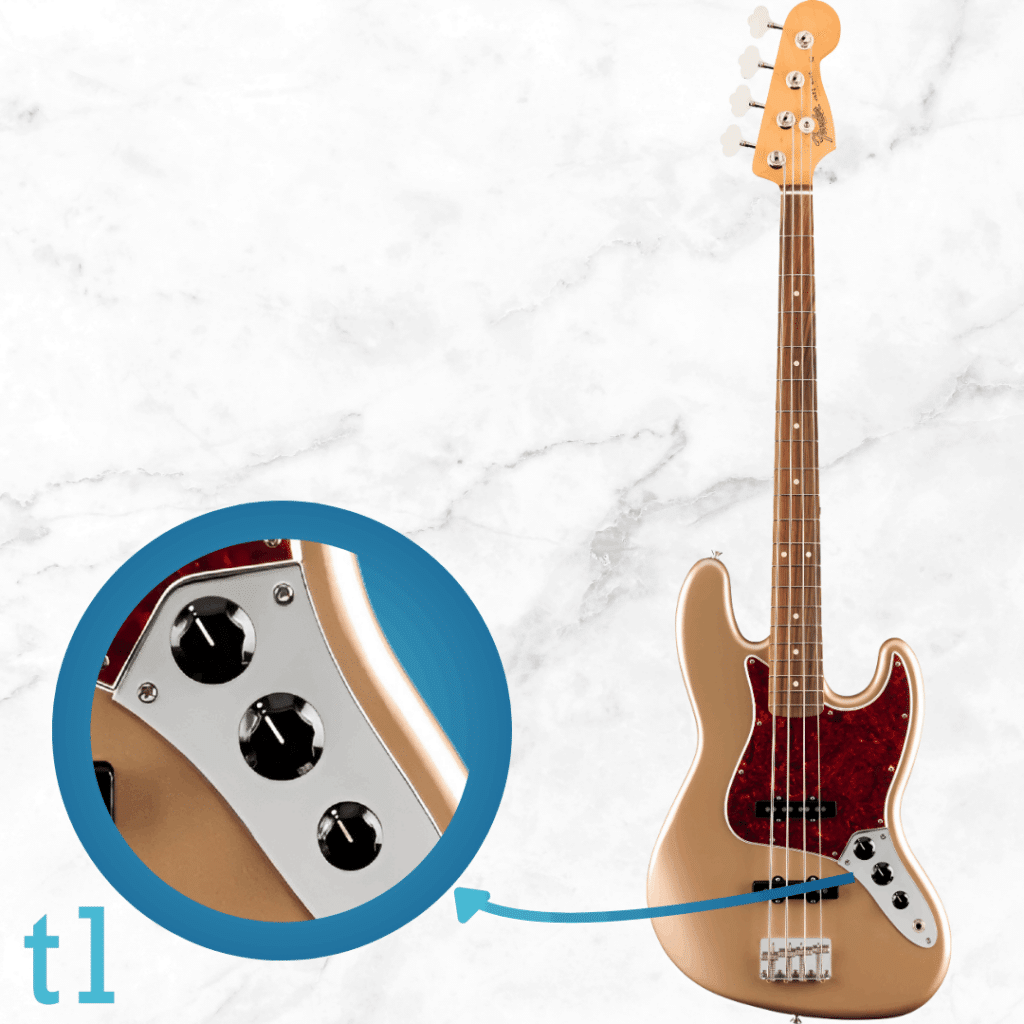
Pickguard
The pickguard isn’t just there to make your bass look snazzy; it serves as a trusty shield.
This guardian protects the body of your bass from scratches and wear caused by picks or fingers.
Depending on your bass model, the pickguard might house electronics too, keeping them safe and sound.

Output Jack
Lastly, meet the output jack, your cord’s best friend. This little portal is where you connect your bass to the amp, breathing life into your music.
It’s small but mighty—ensuring the signal from your pickups is transferred to your amplifier with minimal loss.
Keep an eye on this fellow; a loose jack can mean the difference between rocking out and radio silence.
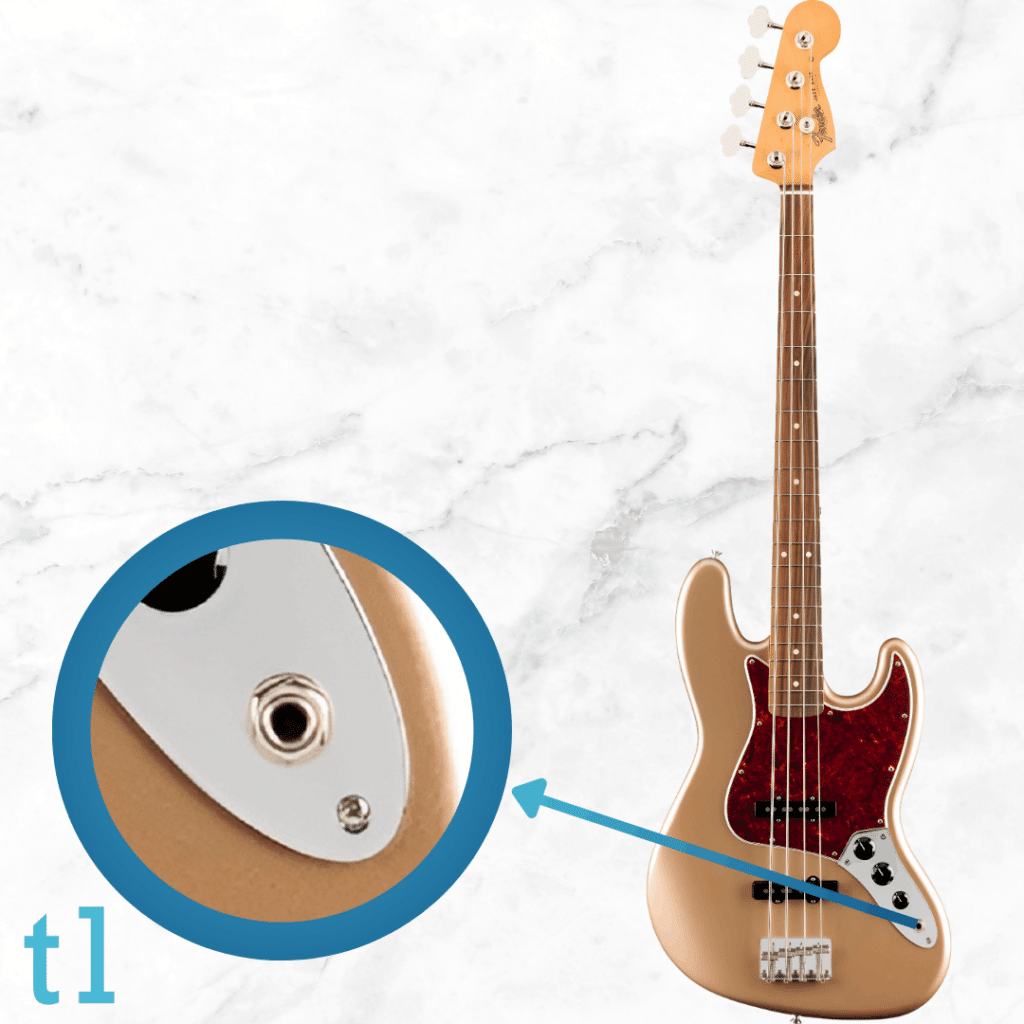
Strings and Tuning
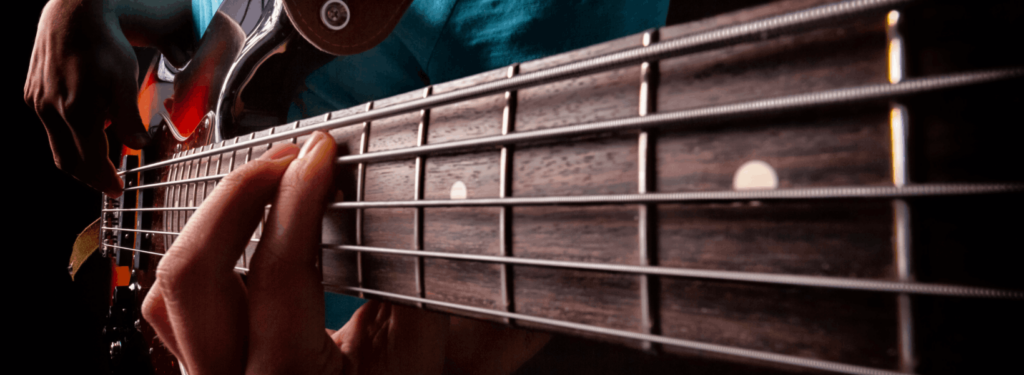
When you pluck a bass string on your bass guitar, it’s not just any vibration; it’s a carefully orchestrated dance of tension, pitch, and resonance.
How you set up your strings and tune them can change everything from the style of music you’re playing to the feel of your instrument.
Types of Strings
Your bass guitar strings come in several flavors, each with a unique character. Roundwound strings are the go-to for many players, favored for their bright sound and pronounced sustain.
They’ve got a wire that’s literally wrapped around the core, which makes them rugged and rich in harmonics—perfect for that groovy bass line in your head.
If you’re curious about the more technical side, string width (or gauge) changes your playing experience too. Choose heavier strings for a deeper tone or go light for ease of play, but keep in mind, the thicker the string, the more tension it requires.
Fun fact: the famous Fender Precision bass often sports roundwound strings, contributing to its iconic sound. These strings offer a blend of bright and mellow tones, making them suitable for both electric and acoustic bass guitars.
Tuning and Tension
Now, let’s talk about tuning your bass. It’s simpler than you might think! Your bass typically has four strings tuned to E, A, D, and G.
This gives you a wide range of pitches—from the low throbbing E string to the zingy twang of the G string. Cranking those tuning pegs at the headstock tightens or loosens the strings, and voilà—you’ve found your pitch.
Remember, correct tension is a balancing act. Too tight, and your strings might snap like an overcooked spaghetti noodle; too slack, and they’ll flop around with all the enthusiasm of a wet noodle.
But get it just right, and your bass will resonate with every note, promising enough groove to get a statue tapping its toes.
3 Recommended Bass Guitars
LA Bass Guitar by Gear4music, Red

PERFECT FOR: Beginner bass players
FEATURES: 20 Frets
OTHER INFO: Comes with 1/4" jack cable and fitted gig bag
LA Bass Guitar by Gear4music, Red
- Crisp, clear tone with good low end depth, punch and sustain
- Lightweight & comfortable body
- Impressive build quality at low cost
- Improved tone and volume
- Excellent value for money
- Limited range of sounds
When you click ‘Check Price’, you’ll see there are loads of great places to buy this item. Our personal favorite is Sweetwater for the US, and Thomann and Gear4Music for the UK & Europe.
They are the largest music retailers, with excellent customer service, competitive prices, really fast shipping, and the longest guarantees.
The professional musician who wrote this article combined many things,
from the product build, manufacturer’s reputation through to feedback
from other users, to create our famous TedScore™.
Ibanez SRMS805 Bass Workshop, Tropical Seafloor

PERFECT FOR: Intermediate to Advance
FEATURES: Number Of Frets : 24
OTHER INFO: .045/.065/.080/.100/.130 gauges
Ibanez SRMS805 Bass Workshop, Tropical Seafloor
- Incredible playability for complex runs and licks
- Punchy bass sound with a wide tonal range
- Powerful bridge pickup to cut through the mix
- Warm neck pickup perfect for blending in with other instruments
- Active three-band EQ control section lets you dial in your perfect tone
- Mono-rail bridge for reliable, strong string performance
- High price tag
- Not suitable for amateurs
When you click ‘Check Price’, you’ll see there are loads of great places to buy this item. Our personal favorite is Sweetwater for the US, and Thomann and Gear4Music for the UK & Europe.
They are the largest music retailers, with excellent customer service, competitive prices, really fast shipping, and the longest guarantees.
The professional musician who wrote this article combined many things,
from the product build, manufacturer’s reputation through to feedback
from other users, to create our famous TedScore™.
Jackson JS Series Concert Bass Minion JS1X, Satin Black
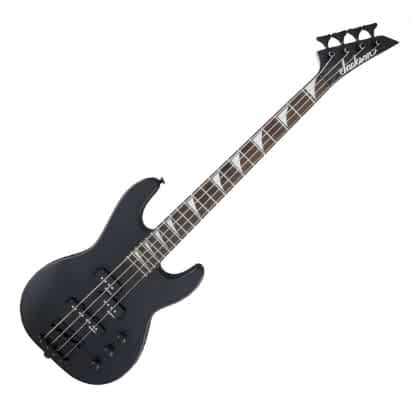
PERFECT FOR: Beginner bassists
FEATURES: Short scale bass of 28.6''
OTHER INFO: 22 Jumbo frets
Jackson JS Series Concert Bass Minion JS1X, Satin Black
- Lightweight body makes it easy to manoeuvre and play
- Dual humbuckers give more options for sound
- Short scale length makes playing easy and accessible
- Black hardware, hardtail bridge and sealed diecast tuners offer superior tuning stability and sustain
- Pearloid sharkfin inlays offer a stylish look
- Not suitable for heavier genres of music, such as metal or punk
- Frets can be hard to adjust for some players
When you click ‘Check Price’, you’ll see there are loads of great places to buy this item. Our personal favorite is Sweetwater for the US, and Thomann and Gear4Music for the UK & Europe.
They are the largest music retailers, with excellent customer service, competitive prices, really fast shipping, and the longest guarantees.
The professional musician who wrote this article combined many things,
from the product build, manufacturer’s reputation through to feedback
from other users, to create our famous TedScore™.
Parts Of The Bass Guitar
Summary
As a bass enthusiast, I’ve learned that your bass guitar is more than just an instrument – it’s your musical sidekick, ready to groove with you.
Feel free to jazz up your bass guitar! Whether you’re itching to swap out your pickups for a punchier sound or fine-tune your strings for that perfect thump, remember it’s your musical buddy.
Stay familiar with all its bits and bobs – they combine to make your groove possible. Keep ’em in check by:
- Pickup Tweaks: Change ’em for variety in your sound palette.
- String Swaps: Keep ’em fresh for maximum vibe and tune.
- Fretboard Care: A bit of lemon oil goes a long way for slick slides.
Your bass is more than wood and wires; it’s a part of you. So treat it well, and storage is key. Tuck it snugly on a stand or keep it high on a wall hanger.
Watch out for the humidity – it’s a sneaky beast that loves to warp wood. Remember, your bass’s best feature is its ability to evolve with you.
As you play, learn, and perform, it adapts. So turn those knobs, adjust that bridge, and let your bass shine. Keep grooving, and let the good times roll!
But before you go…
Get set to discover the ideal bass guitar to kick off your musical journey! Check out our best recommendations in this next post!
FAQ's
The main components of a bass guitar include the body, neck, and headstock. The body houses the pickups, bridge, and control knobs, while the neck holds the fretboard and tuners. The headstock is where the tuning pegs are located, allowing you to adjust the tension of the strings.
The three main parts of bass guitars are the body, neck, and headstock. The body houses the pickups, bridge, and control knobs, while the bass guitar neck holds the fretboard and tuners. The headstock is where the tuning pegs are located, allowing you to adjust the tension of the strings.










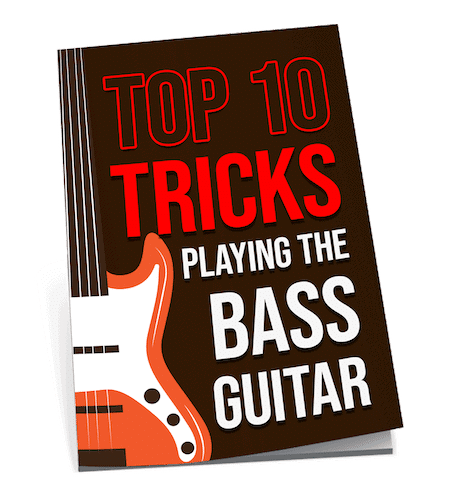
In the section regarding pickups, it might be worth noting the difference in sound characteristics between single-coil and humbucker pickups. This information can profoundly impact a novice’s decision-making process when choosing their first bass guitar. Overall, a solid article on bass guitar components, Lewis.
LOVED the part on tuning n tension. always struggled with it but this makes so much SENSE. thx Lewis!
hey Lewis, did u cover anything about flatwounds vs roundwounds in the strings section? didnt see it and i think that’s key info for tone chasing
StringBender has a point. The type of strings significantly affects the tone and feel of a bass. Roundwounds are brighter and more articulate, while flatwounds offer a smoother, mellow sound. It’s crucial for players to know this.
Great breakdown of the bass guitar components, Lewis Turner! I’ve recently started getting into modding my own bass and found the sections on electronics and hardware super helpful. The bit about the output jack and control knobs got me thinking… maybe it’s time for some upgrades on my own gear. Also, props for including a section on types of strings – it’s something beginners often overlook but makes a huge difference in playability and sound.